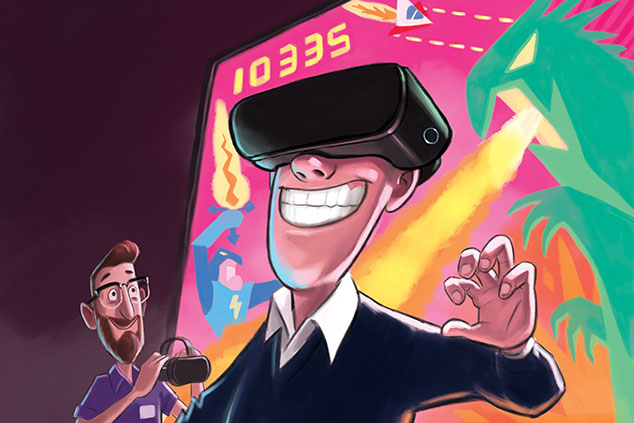How investors can profit from the dawning of a new reality
Widespread use of virtual-reality technology has been “just around the corner” since the 1980s, says Ben Judge. But with the growing popularity of augmented reality, we might finally be about to turn that corner.

"Suppose I make it so that you are in the story... and instead of being on a screen, the story is all about you, and you are in it." Pygmalion's Spectacles, Stanley G. Weinbaum
Virtual reality (VR) a holy grail of computer gamers who want a totally immersive experience has been "just around the corner" for years now. It's not a new concept it first appeared in 1935 in Stanley G. Weinbaum's science fiction short story, Pygmalion's Spectacles, according to Mike Colagrossi onBig Think. But it wasn't until 1981 that the phrase "virtual reality" appeared. It was reportedly coined byJaron Lanier, a computer scientist, author, artist and philosopher, on whom the lead character in 1992 film The Lawnmower Man in which a scientist conducts VR experiments on his gardener with the aim of making him a genius is said to be based.
Since the advent of computers, many manufacturers have tried to bring the concept to life. But it has eluded them. The hardware and software has just not been good enough. True, gamers now have a decent cropof headsets with Facebook's Oculus (Facebook believes the future of VR lies in social gaming Mark Zuckerberg has said he wants a billion people to be using the technology), HTC's Vive, Samsung's Gear and Sony's PlayStation VR among the most popular devices.
MoneyWeek
Subscribe to MoneyWeek today and get your first six magazine issues absolutely FREE

Sign up to Money Morning
Don't miss the latest investment and personal finances news, market analysis, plus money-saving tips with our free twice-daily newsletter
Don't miss the latest investment and personal finances news, market analysis, plus money-saving tips with our free twice-daily newsletter
But VR games have been the "next big thing" for some time now and, while the hardware is getting better and game developers are producing more appealing titles, it does seem that mass adoption is still "just around the corner".
But VR is just part of the picture and only a small part at that. Most players are betting that the future lies not so much in VR, but in "augmented" reality (AR). Estimates of the size of these markets vary wildly. But most believe the AR market will be at least four times the size of the VR market. Tim Merel, writing on venturebeat.com, reckons the global AR market could top $75bn in revenue by 2023, while the VR market could be worth up to $15bn.
Zion Market Research, meanwhile, estimates that the global AR and VR market will hit $814.7bn by 2025, up from just $26.7bn in 2018. Whichever figure you opt for, it's clear that a significant new market is opening up.
AR, VR what's the difference?
With a VR set-up you are separated from the outside world and immersed as fully as possible in the computer-generated world. With AR and closesibling mixed reality (MR), computer-generated graphics are overlaid on a view of what is actually in front of you. These overlays add information and, in the case of MR, allow you to manipulate the computer-generated elements.
In practice, the two terms are virtually interchangeable. Not having to immerse yourself fully in the virtual world has advantages in hardware terms you're not restricted to a cumbersome headset and for many applications you can use your phone's screen, camera and processing power.
Indeed, much of the consumer market is focused on mobile AR, using smartphones. One of the most high-profile examples of AR is the mobile-phone game Pokmon Go, which swept the world in 2016. In it, players roam the streets collecting cartoon figures that hide in the real world. It was downloaded more than 750 million times in its first year. A more recent example is the Harry Potter: Wizards Unite game, from the same company, Niantic, which was released in June. The game is played out in the real world players interact with computer-generated items displayed on their phone screens.
It's not just gaming
Other examples of consumer AR applications include Gatwick's award-winning AR smartphone app that helps travellers to navigate through the airport's two passenger terminals. The app will guide you through check-in, security and the consumer hellscape of the departure lounge, and provides flight updates, queue times, chatbots and more than 2,000 indoor beacons to help you find your way. Not only does it help passengers avoid getting lost, but the data it gathers on how they travel through the terminals is also invaluable to the airport and its business partners.
Google has done a similar thing with its Maps app. Its Live View AR mode still in beta testing lets you use the phone's camera to see the scene around you, overlaying arrows and directions to help you get to where you are going without getting lost. Retailers are keen on AR, too. Ikea's app allows you to visualise its furniture in your house to check that it fits in both size and style. Lacoste has an app that lets you try on shoes, while Topshop does the same with clothes.
You may even remember that Google had a stab at popularising consumer AR goggles with its "Google Glass". These were "smart glasses" with a processor, camera and heads-up display that were announced in 2012. In 2013 early adopters, called "Glass Explorers" by Google, could buy a pair for $1,500, and the product went on public sale in 2014.
Glass could take photos and record video, while users could tell the device to launch a search for what they were looking at, with the results appearing to float in their line of vision. But despite substantial hype when it was launched, it wasn't well received. It made users look like a bit of an idiot. And it came with a host of privacy concerns many people were uncomfortable with the idea that all their actions in the company of the wearers (quickly named "Glassholes" by some of the more hostile media wags) could be recorded without their knowledge. Some establishments banned them. As a result, Google pulled the plug in 2015.
Enterprise AR is attracting the tech giants
But rather than consumer AR, it is in business (or enterprise) applications that AR is really starting to take off. Index AR Solutions, which builds AR apps for businesses, believes that in the US alone the market for enterprise AR applications and systems could be worth $105bn by 2031, split between software, worth $11bn; services, $45.4bn; and hardware, worth $49.4bn.
When it stopped selling its Glass headset to consumers, Google didn't give up altogether. It continued development with an "enterprise edition", which is currently being used by a surprising number of companies worldwide. It released its Enterprise Edition 2 in May, and reports suggest that Google has finished development of the third generation, which it may be about to put into production.
Volkswagen has been piloting an AR project at its plant in Wolfsburg, Germany. Around 30 workers fulfilling orders are using Google's glasses with software developed by Ubimax, a privately held company specialising in AR applications. The information on parts, including identification and location, appears in the worker's field of vision, with the camera acting as a barcode reader that can identify which parts have been picked. Ubimax's software is also used by Samsung, DHL and Intel. German company Picavi also sells similar picking software for warehouse and logistics workers.
AGCO, an American agricultural products manufacturer, is using 100 pairs of Google Glasses at its tractor factory in Minnesota, along with software from Proceedix. It uses what it calls "assisted reality", a form of AR, to help in quality-control inspections, which it says has reduced inspection time by 30% and eliminated paperwork. The company is so happy with the technology that it plans to extend its use to six more factories. And aeroplane-maker Boeing uses "Skylight" software from Washington DC-based Upskill to guide technicians wiring planes. It claims to have cut production time by 25% and lowered the rate of errors to nearly zero. Boeing's venture-capital arm, HorizonX, has invested in Upskill, Reuters reported in 2017.
The big-name companies working in AR
Microsoft's HoloLens is a similar enterprise proposition it launched with hopes that it would take off on a consumer level, but has become "a tool that can be genuinely useful for a wide range of businesses", says TechRadar. And its soon-to-be-launched HoloLens 2 is aimed squarely at businesses. It is working with Philips, which is using the HoloLens to allow doctors to see "inside" patients when performing surgical procedures. Microsoft is also planning tie-ups with the likes of Pearson, Bosch and Upskill.
Microsoft has produced a suite of apps for use with the HoloLens hardware, but, as with Google, it will allow third-party developers to create applications. Nasdaq-listed Trimble (Nasdaq: TRMB) produces a hard-hat that incorporates the HoloLens. Used with its Trimble Connect program, it allows workers on construction sites to visualise proposed elements of the planned construction over the current state of the site, potentially eliminating the need for many time-consuming physical drawings.
As far back as 2017, Bloomberg reported that Apple was working on an "AR headset to succeed [the] iPhone", which was supposed to be ready in 2019for shipping in 2020.It quotes Apple CEOTim Cook as saying "AR is going to change the way we use technology forever".
The company is working on several projects under the code-name "T288", says Bloomberg. And it bought German AR developer Metaio in 2016. But a launch depends on the technology being able to meet the demands of Apple's design team. They're not going to build and release some clunky-looking abomination. Recently departed design chief Jony Ive told The Independent back in 2017 that there was nothing on the market they would be happy with in terms of design, and that they were "waiting for the technology to catch up with the idea".
Will Apple launch AR any day now?
Given Apple's record of taking badly designed good ideas and repackaging them into world beaters, its entry into the market could be a significant step. MP3 players were around before the iPod; smartphones were around before the iPhone; and smart watches were around before Apple's Watch. But it took Apple's designs to make them cool, easy to use and ready for genuine mass adoption.
It might take some time. There are rumours circulating in the technology press that Apple has already disbanded its AR glasses team, such is the difficulty in coming up with an acceptably sleek device that can do all the things that the designers want it to do. Or it might not other commentators believe development has stopped simply because the glasses, which would be paired with an iPhone, are ready for production and could be on sale as early as 2020.
Certainly, said Macworld in May, "with Google and Microsoft actively developing AR devices, it seems like a party Apple can't afford to miss". And Bloomberg's original report of a 2020 release date "is looking increasingly likely". If Apple does join the VR party, you can expect consumer uptake to explode.
Apple has developed its ARKit for iOS devices, which enables external developers to build AR applications for iPhones and iPads. And it is likely that if and when Apple's AR glasses do arrive, they will, much like the Apple Watch, be an extension of your phone rather than a standalone device.
Military uses
Of course, VR and AR technology both have huge military applications. Indeed, the origins of the "heads-up" display lie in combat aircraft. Defence giant BAE is working on "vehicles of glass", says TechRadar, where operators of armoured combat vehicles use sensors to give them a 360-degree view of what's outside. And developers are coming up with "tactical augmented reality" a heads-up display for foot soldiers, which will be able to help them orientate themselves and identify where everyone is on the battlefield both friend and foe.
Each soldier will be networked with the rest of his platoon; they will be able to see the terrain they are operating in, with map overlays and information from weapons' sights, which will allow unprecedented accuracy when firing. The US Army has been trying to perfect such a system since its Land Warrior System of the late 1980s and 1990s. The technology is not yet mature enough to provide all this information in a suitably miniaturised, rugged, power-efficient manner. But it's only a matter of time. We look at the most promising investments below.
How can you invest in VR and AR?
Investing in pure-play AR and VR companies is tricky as with so many of today'stech-heavy themes. Listed companies that focus solely on VR and AR are rare. There are many small, privately held companies to watch, in the hope that they come to the public markets in the future.
Some are mentioned above; others include Chinese start-up Rokid, US start-up Magic Leap, and Israel's Lumus.But the biggest investors are the big-tech companies Alphabet (Google), Facebook, Sony and Apple, for example.One option for investors is Qualcomm (Nasdaq: QCOM), which makes the Snapdragon chip that forms part of many of the current crop of headsets.But a better bet might be Taiwanese phone-maker HTC Corporation (Taiwan: 2498).
As well as smartphones which will be the platform for much of consumer AR it also makes VR headsets. But unlike, say, Facebook's Oculus, which is aimed firmly at the consumer, HTC sees the enterprise market as its focus, says Travis Hoium on the Motley Fool. It may not sell as many headsets as Oculus, but it hopes that those it does sell will fetch a premium price. HTC's latest annual report claims 2018 was a "bumper year" for its VIVE VR business. It has been struggling lately, and is not currently profitable, but losses are narrowing.
It recently pulled all its phones from the UK market, as a long-running intellectual property dispute with German company IPCom comes to a head. That knocked 7% off its share price. But if you're a big believer in AR, it may be an opportunity.MicroVision (Nasdaq: MVIS) makes ultra-small laser sensors and scanners that can project to HD displays (eg, onto a car's windscreen or onto a head-mounted display), but it's probably one to avoid.
It is not yet profitable, and lost $9m in the second quarter on revenues of $1.2m down from $2m in the same period last year. The share price has fallen from $0.97 a year ago to $0.59 now. It has just placed a few million shares and raised $2m to give it enough cash to continue to the fourth quarter of 2019, but management warns there is "substantial doubt" as to whether it can continue as a going concern.
Meanwhile, Vuzix (Nasdaq: VUZI), which produces a range of smart glasses and AR products for the consumer and enterprise markets, hasn't been a stellar investment either. It lost $6.4m in its last quarter on revenue of $1.4m and its share price has fallen from $6.40 a year ago to just $2 now. However, chipmaker Intel saw some value in the company back in 2015, and stumped up $25m; it now owns almost 50,000 convertible preferred shares, which, if converted, would represent an 18% stake. And just last month, Vuzix raised $20m from "two large institutional investors". It aims to be "cash flow break-even" by the end of the year.
Kopin (Nasdaq: KOPN) builds microdisplays and headsets. The company recently announced that its display technology is being used by Google in its Glass Enterprise Edition 2; it also makes systems for the US military. It's been around since 1984. However, it has been making a loss for a while and has significant debt. It has just released its results for the second quarter revenue rose to $9.1m, up from $5.9m in the same period last year, and losses fell from $9.2m to $4.3m. So it is travelling in the right direction, at least.
Get the latest financial news, insights and expert analysis from our award-winning MoneyWeek team, to help you understand what really matters when it comes to your finances.
Ben studied modern languages at London University's Queen Mary College. After dabbling unhappily in local government finance for a while, he went to work for The Scotsman newspaper in Edinburgh. The launch of the paper's website, scotsman.com, in the early years of the dotcom craze, saw Ben move online to manage the Business and Motors channels before becoming deputy editor with responsibility for all aspects of online production for The Scotsman, Scotland on Sunday and the Edinburgh Evening News websites, along with the papers' Edinburgh Festivals website.
Ben joined MoneyWeek as website editor in 2008, just as the Great Financial Crisis was brewing. He has written extensively for the website and magazine, with a particular emphasis on alternative finance and fintech, including blockchain and bitcoin.
As an early adopter of bitcoin, Ben bought when the price was under $200, but went on to spend it all on foolish fripperies.
-
 Boost for over 100,000 families on Child Benefit as new HMRC payment system rolled out
Boost for over 100,000 families on Child Benefit as new HMRC payment system rolled outThousands of households will no longer have to pay the dreaded High Income Child Benefit Charge through self-assessment
-
 Are you being haunted by the ghost of Christmas past? How festive cutbacks could boost your long-term wealth
Are you being haunted by the ghost of Christmas past? How festive cutbacks could boost your long-term wealthThe average family spends around £1,000 over the Christmas season. Here’s how much you could have gained if you had invested some of the money instead.
-
 Governments will sink in a world drowning in debt
Governments will sink in a world drowning in debtCover Story Rising interest rates and soaring inflation will leave many governments with unsustainable debts. Get set for a wave of sovereign defaults, says Jonathan Compton.
-
 Why Australia’s luck is set to run out
Why Australia’s luck is set to run outCover Story A low-quality election campaign in Australia has produced a government with no clear strategy. That’s bad news in an increasingly difficult geopolitical environment, says Philip Pilkington
-
 Why new technology is the future of the construction industry
Why new technology is the future of the construction industryCover Story The construction industry faces many challenges. New technologies from augmented reality and digitisation to exoskeletons and robotics can help solve them. Matthew Partridge reports.
-
 UBI which was once unthinkable is being rolled out around the world. What's going on?
UBI which was once unthinkable is being rolled out around the world. What's going on?Cover Story Universal basic income, the idea that everyone should be paid a liveable income by the state, no strings attached, was once for the birds. Now it seems it’s on the brink of being rolled out, says Stuart Watkins.
-
 Inflation is here to stay: it’s time to protect your portfolio
Inflation is here to stay: it’s time to protect your portfolioCover Story Unlike in 2008, widespread money printing and government spending are pushing up prices. Central banks can’t raise interest rates because the world can’t afford it, says John Stepek. Here’s what happens next
-
 Will Biden’s stimulus package fuel global inflation – and how can you protect your wealth?
Will Biden’s stimulus package fuel global inflation – and how can you protect your wealth?Cover Story Joe Biden’s latest stimulus package threatens to fuel inflation around the globe. What should investors do?
-
 What the race for the White House means for your money
What the race for the White House means for your moneyCover Story American voters are about to decide whether Donald Trump or Joe Biden will take the oath of office on 20 January. Matthew Partridge explains how various election scenarios could affect your portfolio.
-
 What’s worse: monopoly power or government intervention?
What’s worse: monopoly power or government intervention?Cover Story Politicians of all stripes increasingly agree with Karl Marx on one point – that monopolies are an inevitable consequence of free-market capitalism, and must be broken up. Are they right? Stuart Watkins isn’t so sure.

